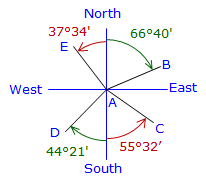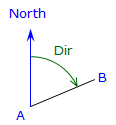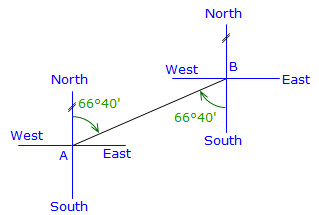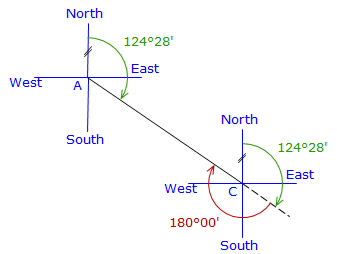2. Direction
A direction is angle from a meridian to a line. It is similar to a horizontal angle in a traverse except the backsight is always along the meridian, Figure A-3.
|
|
|
Figure A-3 |
There are two different ways to express line direction: bearing and azimuth.
a. Bearing
A bearing is an angle from the North or South end of the meridian turned to the East or West. A bearing has three parts:
- Prefix - N or S indicating which end of the meridian is turned from.
- Angle
- Suffix - E or W indicating turning direction from the meridian to the line.
N 66°40' E - from the North end of the meridian, turn 66°40' to the East.
Example
 |
Bearing AB = N 66°40' E Bearing AC = S 55°32' E Bearing AD = S 44°21' W |
| Figure A-4 Bearings |
A bearing falls in one of four quadrants so the angle does not exceed 90°. The angle is to the right (clockwise) in the NE and SW quadrants, to the left (counter-clockwise) in the SE and NW quadrants. A due North direction can be expressed as either N 00°00' E or N 00°00' W; due East as N 90°00' E or S 90°00' E; similarly for dues South and West.
A back-bearing is reverse of a bearing, that is, Bearing BA is the back-bearing of Bearing AB. Because the meridians are parallel at both ends of the line, the bearing angle is the same but quadrant is reverse. This is true only when meridians are parallel. Where meridians converge, the forward and back bearing angles will differ by the total convergence. More on this later.
|
|
Bearing AB = N 66°40' E
|
| Figure A-5 Back Bearing |
b. Azimuth
An azimuth is an angle to the right (clockwise) from the meridian to the line. In most cases the azimuth is turned from the north meridian end; earlier control surveys used the south end. An azimuth varies from 0° to 360°.
Example
|
|
Azimuth AB = 66°40' Azimuth AC = 124°28' Azimuth AD = 224°21' Azimuth AE = 322°26' |
| Figure A-6 Azimuths |
A back-azimuth is reverse of a azimuth: Azimuth CA is the back-azimuth of Azimuth AC. Because the meridians are parallel at both ends of the line, the back-azimuth and forward azimuth differ by 180°. As with bearings, this is true only when meridians are parallel. Where meridians converge, the forward and back azimuths will differ by (180° ± total convergence). More on this later.
Example
|
|
Azimuth AC = 124°28' Azimuth CA = 124°28' + 180°00' = 304°28' |
|
Figure A-7 |



